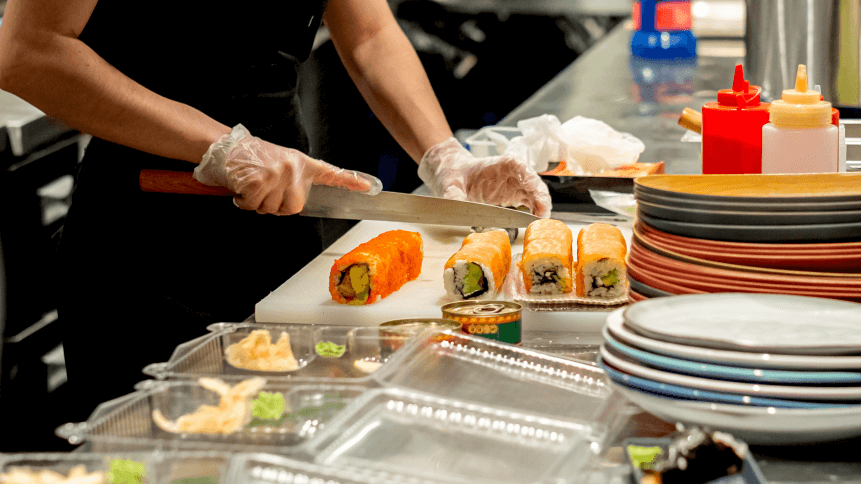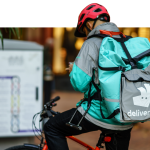Ghost kitchens are thriving in 2020 — but is that a good thing?

- Without a visible, physical presence, ghost kitchens are rising phenomena leveraging the ‘platformification’ of the food delivery market
- More reliance on deliveries this year has accelerated this industry. Specialist Reef Technology recently landed US$700 million
- There could be no going back — but what does this mean for the food industry?
Lockdowns and social distancing measures have had shutters grinding up and down for those in the restaurant business, without any sort of predictability — fortunately, demand for takeaways has helped to keep the fryers on.
The global online food delivery services market has reached a value of over US$110 billion in 2020; couriers of the Deliveroo, Uber Eats, DoorDash and Just Eat ilk remain the archetypes of the gig-economy, feeding an ever-increasing demand for convenient food deliveries across an always-expanding range of culinary worlds.
Part and parcel of delivery services’ meteoric rise over the last decade – and especially over the last two years – has been the emergence of virtual restaurants, otherwise known as ghost restaurants or ghost kitchens.
This phenomenon, pioneered by Deliveroo in 2018, involves the conversion of real estate into kitchen facilities, and their subsequent lease to chefs and small-business owners who do not have their own brick-and-mortar spaces. Customers using delivery apps would assume these outlets have a physical on-street presence. But, they are, for all intents and purposes, delivery-only kitchens.
Reef Technology — a sign of the market direction
Servicing 4,500 locations, Miami-based Reef Technology is the largest operator of mobility, logistics hubs, and neighborhood kitchens. The firm is leading the rise of ghost kitchens in the US and just raised US$700 million for the continued development of “neighborhood hubs” – spots for local businesses to start out and make their name.
TechCrunch anticipates Reef will use the funds to scale to around 10,000 locations in the States. Reef’s massive haul comes as ghost kitchens, virtual restaurants, and virtual food halls are becoming an integral part of the restaurant industry. Euromonitor predicts the ghost kitchen sector will be worth US$1 trillion within the decade.
According to an investigative piece in The New Yorker, “Reef envisions greener, less congested, more accessible cities, in which delivery fleets zip around on electric bicycles and people congregate for cocktails in rooftop gardens, planted atop defunct parking structures.”
The is all sounds like a lovely, utopian vision of the future, but it’s one offset by lingering question marks over the long-term impacts of ghost kitchens on the existing restaurant market. Ghost kitchens are becoming an ever-more crowded venture – Reef, Zuul and Kitchen United have cornered the market in the United States, Deliveroo in the UK, and increasingly across Europe, and Panda Selected in China. Likewise, Uber Eats has now facilitated over 8,000 virtual kitchens in the US. The momentum of the trend may move to usurp, or at the very least leave in the shadows, traditional restaurant dining, and “eating out”.
Some ghost kitchen owners host anywhere between 5 and 30 virtual restaurants. These businesses may even be pedaling the same dishes from the same kitchens under different names to target different pools of consumers – just another way the virtual restaurant industry is so finely tuned with the digital marketplace more broadly.
The evolution of ghost kitchens and their tech
What started as a pursuit to help existing restaurants boost their business or experiment with new ideas, has evolved to the point of new independents and brands emerging at escalating rates. The key is that these businesses can use ghost (or dark) kitchens at a fraction of the cost of a new restaurant retail space. It’s a lower-risk, higher-reward means for entrepreneurs, foodies, or even larger restaurant firms to expand their business.
According to industry analyst, L.E.K., “between 2018 and 2030, restaurant delivery is projected to grow at more than three times the rate of on-premises sales.” Flexibility is the name of the game, and ghost kitchens support it by the bucketload; using technology to monitor demand, operate in a more footloose nature, and respond to instantaneous feedback gives them the edge over set-location restaurants, especially during the current pandemic. Many facilitating businesses (the likes of Reef and Deliveroo) use data-analytics and algorithms to identify opportunities for certain cuisines in certain neighborhoods, then approach existing brick-and-mortar restaurateurs to pitch them the idea of launching a virtual restaurant.
YOU MIGHT LIKE

Just Eat CISO: How to earn respect in cybersecurity
Benefiting the food industry, or taking-away
Virtual restaurants allow upcoming independents and restauranteurs to innovate, develop concepts, and reach wider audiences, with far less risk than in the retail space. No front of house staff are required, no worry over getting seats filled and building ambiance, and fewer physical overheads — there’s more time and money freed up for pure food creation.
It’s also a pretty fair bet that if you offer delivery, you’ll do better than if you don’t, especially when delivery is the only feasible option for eating “out”. Moving to where the need also allows existing restaurants to keep employees on the job and keep them engaged with the brand during the pandemic.
On the other side of the coin, though, there’s the case of virtual kitchens serving as environments that merely meet demand, that de-craft cooking itself: take the passion, atmosphere, theatre, and soul out of it. On-demand platforms like Netflix and Spotify have given us access to media entertainment whenever we want it in one place, but trips with friends and family to the local cinema have become fewer and far between. Ghost kitchens will provide the mechanics to bring dining further into the platform economy, propagating shape-shifting brands and menus, pedaling uniformity, and transferability.
They also mark a furthering of the separation of user experience from human labor. Again, the smash-and-grab gratification of food-app delivery services – though maintaining a semblance of normality in an altogether odd year – may well lead to another form of food factories – ones that meet more precisely, data-informed needs, but do so with eyes only on sales and reach. There have also been investigations into how ghost restaurant brands overlook green ingredients and eco-packaging to maximize profits and lean a little too heavily on emission-producing deliveries.
What is a touch more concrete, however, is that gargantuan investments and unceasing demand mark ghost kitchens as an industry of real clout, and one that Covid-19 — as is the story with digitization everywhere — has accelerated.









